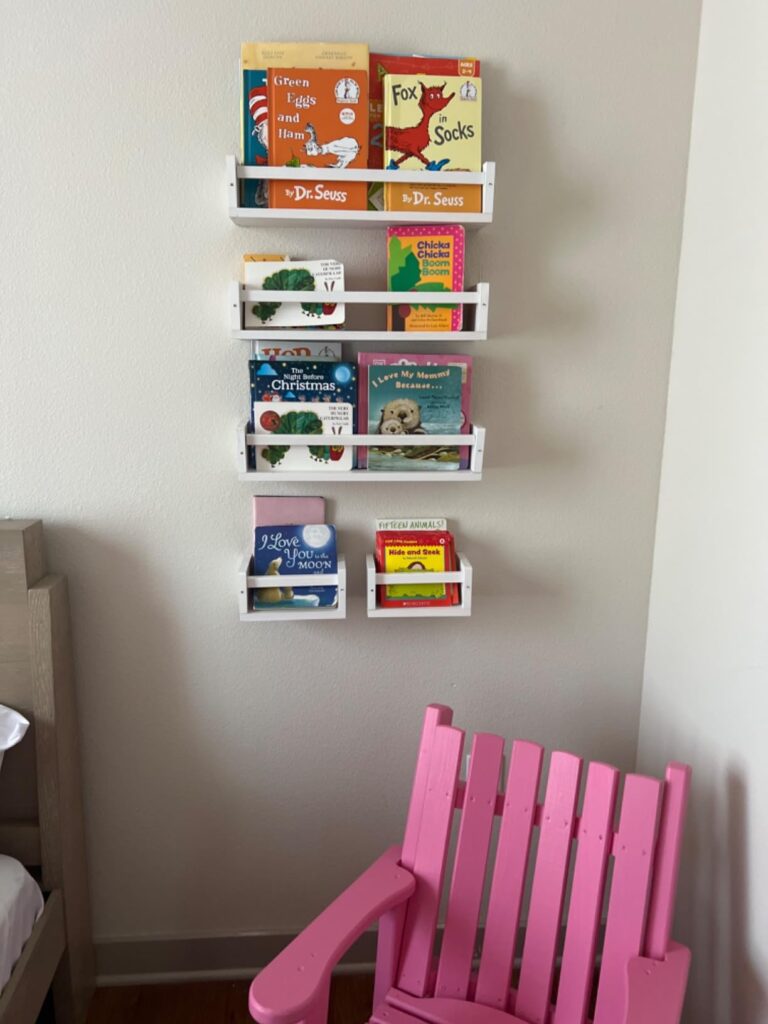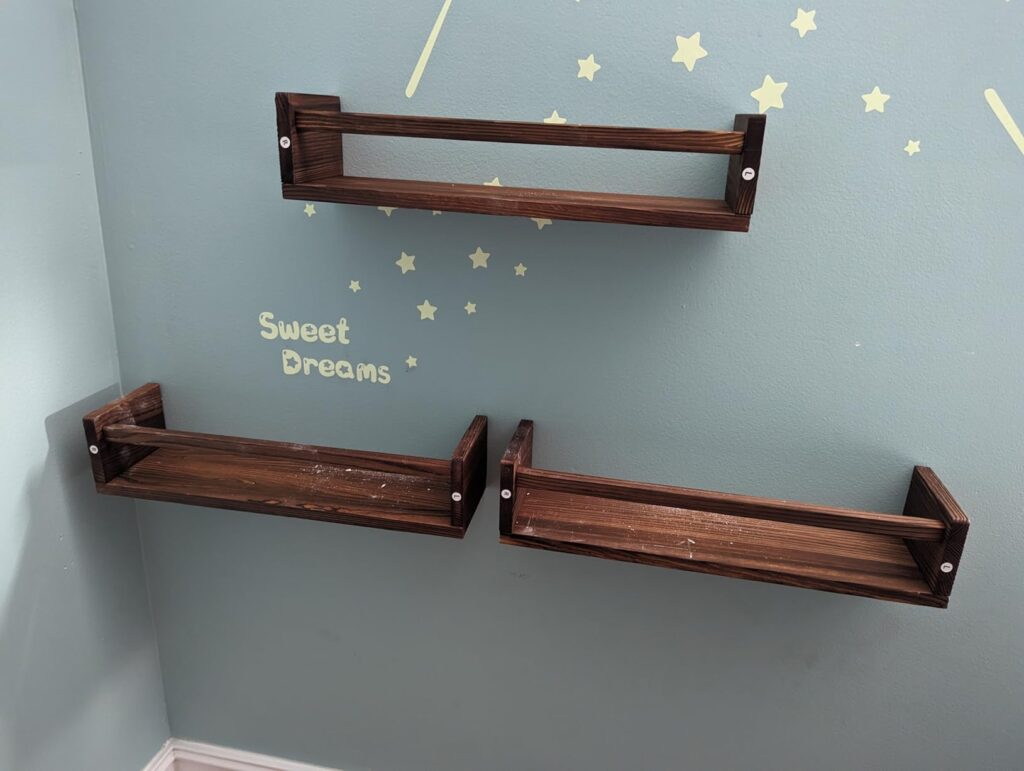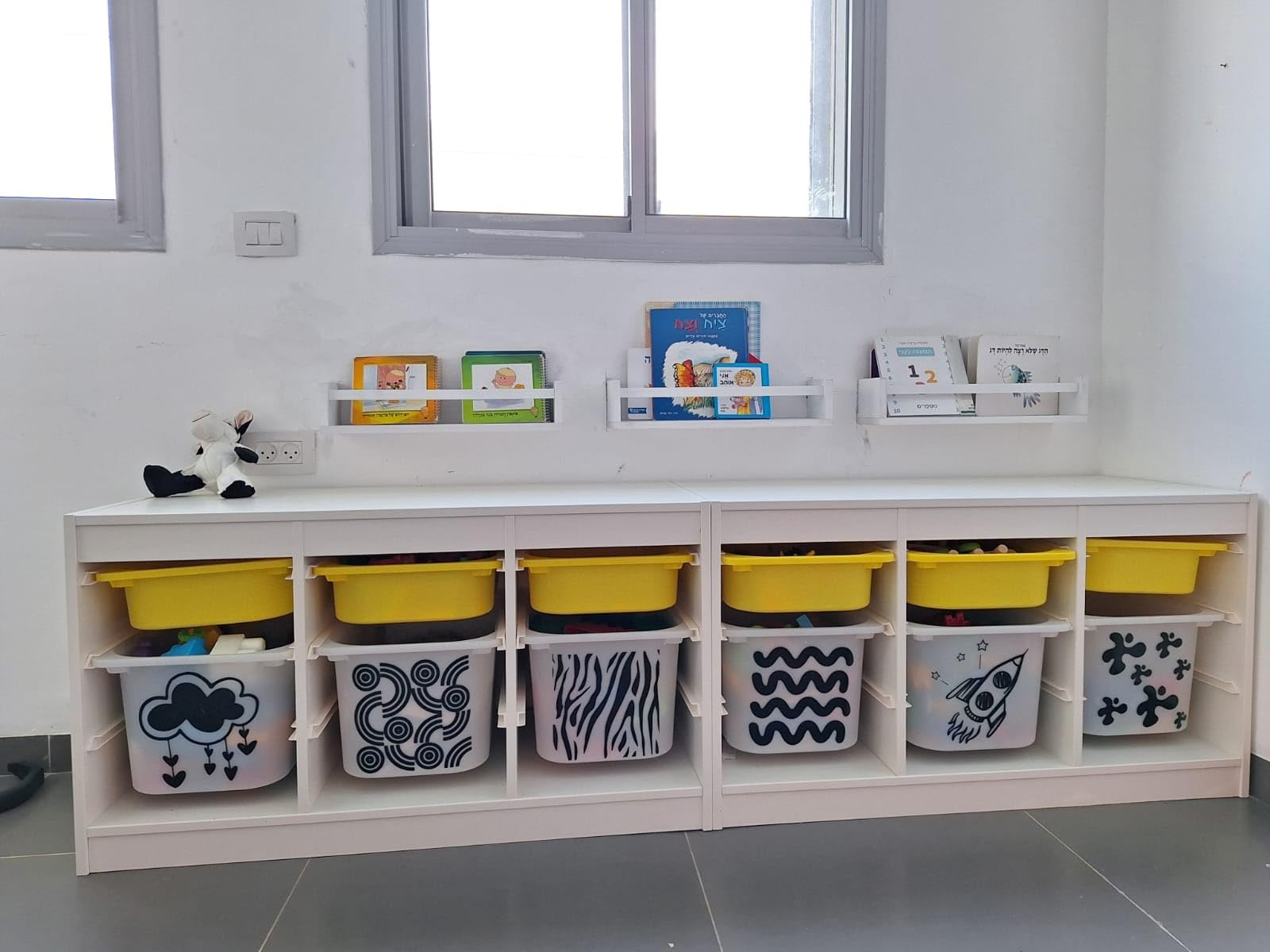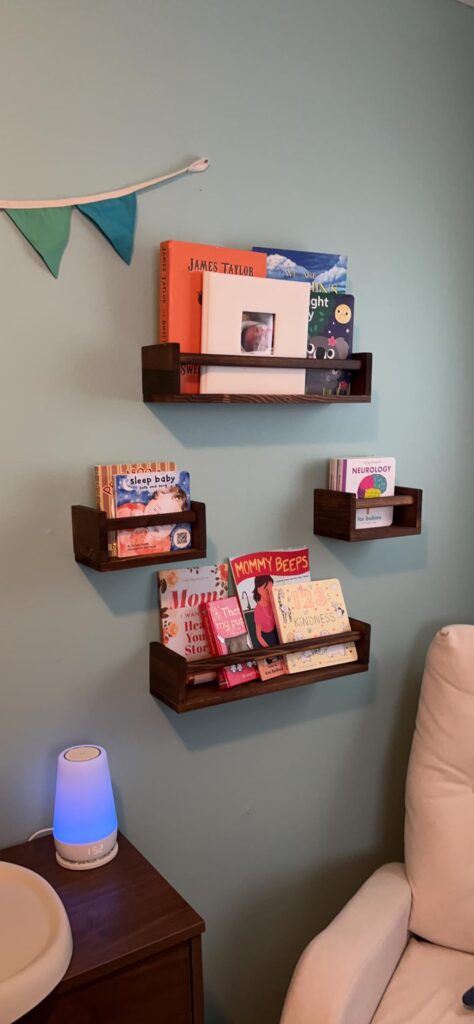Introduction
Let’s face it—keeping a nursery tidy is a full-time job in itself. One minute, you’ve got a Pinterest-worthy setup with neatly stacked books, and the next, it looks like a mini tornado tore through the room. Books are scattered on the floor, crayons are mysteriously wedged between storybooks, and that adorable nursery book shelf you bought? Well, it’s struggling to do its job.
But here’s the thing: an organized nursery book shelf isn’t just about aesthetics. It can make your life easier, foster a love for reading in your little one, and even keep your child safer. In this blog post, we’ll dive deep into nursery book shelf organization tips that will not only tame the chaos but also add a touch of charm to your nursery. From clever storage hacks to DIY projects, and even a few funny stories from parents who’ve been there, this guide has it all.
And if you’re on the hunt for a nursery book shelf that’s stylish and functional, we’ll let you in on why Homey Panda’s nursery book shelf is a top pick among parents—it comes with mini shelves that are perfect for little hands!
So, let’s get started on transforming your nursery from chaotic to cozy.

Why Nursery Book Shelf Organization Matters
You might be wondering—is it really that important to organize a nursery book shelf? After all, your baby isn’t exactly filing books alphabetically or complaining about a messy shelf, right? But the truth is, having an organized nursery book shelf has more benefits than you might think. Let’s break it down.
Encouraging Early Reading Habits
Children are naturally curious, and when books are easily accessible, colorful, and displayed in an inviting way, they’re more likely to pick them up. Think of your nursery book shelf as a mini library designed to spark your child’s imagination.
Imagine this: You’ve got a shelf filled with vibrant picture books, all within your child’s reach. One day, your toddler toddles over, grabs The Very Hungry Caterpillar, and plops down with it in their lap. That’s not just adorable—it’s the start of a lifelong love for reading.
Organizing books in a way that highlights their covers (instead of just the spines) can make a huge difference. Face-out book displays are like mini invitations to read. This is one reason Homey Panda’s nursery book shelf is such a hit with parents—it features mini shelves that are just the right size for showcasing books face-forward.
Maximizing Space in Small Nurseries
Let’s be real—nurseries aren’t always the most spacious rooms in the house. But that doesn’t mean you can’t create an organized and functional reading space. By choosing the right nursery book shelf and organizing it strategically, you can make even the tiniest nursery feel open and clutter-free.
Vertical storage is your best friend here. Tall, narrow bookshelves take up minimal floor space while offering plenty of room for books. You can also use corner shelves or wall-mounted options to free up floor space for other essentials like a rocking chair or toy bin.
Creating a Safe and Kid-Friendly Environment
An often-overlooked benefit of a well-organized nursery book shelf is safety. Bookshelves that are overloaded or poorly secured can pose a tipping hazard, especially once your little one starts to climb and explore. Organizing your shelf thoughtfully ensures that heavier books are placed on lower shelves and that the shelf itself is anchored securely to the wall.
Safety goes beyond just anchoring shelves, though. Opting for rounded edges and using non-toxic materials can make your nursery book shelf safer for curious hands and mouths. Again, Homey Panda’s nursery book shelf shines here with its child-friendly design and sturdy build.
Choosing the Right Nursery Book Shelf for Your Space
Picking the perfect nursery book shelf might seem straightforward, but when you start thinking about safety, functionality, and style, it becomes clear that not all shelves are created equal. The right shelf doesn’t just hold books—it enhances your nursery’s design, keeps your child safe, and makes storytime a breeze. Let’s dive into how to choose the perfect nursery book shelf for your space.
Freestanding vs. Wall-Mounted: Which One’s Right for You
One of the first decisions you’ll face is whether to go with a freestanding or wall-mounted nursery book shelf. Both options have their perks, but choosing the right one depends on your nursery’s size, layout, and your personal style.
Freestanding Shelves:
Freestanding shelves are versatile and can be moved around as your nursery evolves. They come in various shapes and sizes, from traditional bookshelves to ladder-style designs. If you have a bit of extra floor space and want something that can grow with your child, a freestanding nursery book shelf is a great option.
However, freestanding shelves need to be anchored to the wall for safety—especially once your little one starts pulling themselves up or climbing. Trust me, you don’t want to walk in and find your toddler scaling the bookshelf like a mini mountaineer!
Wall-Mounted Shelves:
If you’re working with limited space or just love a minimalist look, wall-mounted shelves are a lifesaver. They free up floor space, making the room feel bigger and less cluttered. Plus, they can be installed at any height, so you can place them low for easy toddler access or higher up to keep certain books out of reach.
Wall-mounted shelves are also perfect for creating a decorative display. Imagine a series of floating shelves with your child’s favorite books, framed photos, and a few plush toys—it’s functional and adorable. This is where Homey Panda’s nursery book shelf really shines. Its sleek, wall-mounted design with mini shelves not only looks great but is perfect for displaying books face-out, inviting your child to dive into storytime.
Consider Shelf Height: For You and Your Little One
When it comes to organizing a nursery book shelf, height matters. You’ll want a shelf that’s accessible for your child but also practical for you.
For Toddlers:
Low shelves are key for toddlers. When books are within their reach, kids are more likely to engage with them independently. This encourages early reading habits and gives your child a sense of ownership over their little library. Plus, it reduces the number of times you’ll hear, “Mom, can you get me that book?”—which, let’s be honest, is a win.
For You:
While it’s great for your child to have easy access to their favorite books, you’ll also want some space for items that are better kept out of reach—like delicate books, decorative items, or those crayons that mysteriously find their way into the weirdest places. A multi-tiered nursery book shelf gives you the best of both worlds.
Future-Proofing Your Shelf:
Think ahead! Your baby won’t stay little forever (though we wish they would, right?). Choose a shelf that can grow with them. Adjustable shelves or modular designs can adapt as your child’s collection of books and toys evolves.
Smart Storage Solutions for Extra Books and Crayons

Let’s be honest—no matter how perfectly you organize your nursery book shelf, there will always be those extra books, rogue crayons, and little odds and ends that don’t quite fit. But don’t worry! With some smart storage solutions, you can keep the chaos under control without sacrificing style. Whether you’re dealing with a growing library or an ever-expanding collection of art supplies, these tips will help you maximize space and keep everything in its place.
Incorporate Storage Bins and Baskets for Small Items
Crayons, markers, tiny board books—these are the culprits that tend to clutter up even the most organized nursery book shelf. The solution? Bins and baskets.
Crayon Chaos, Be Gone!
Designate small baskets or bins specifically for art supplies. Fabric bins are soft, safe, and come in all sorts of fun patterns that can match your nursery decor. Woven baskets add a rustic, homey touch, while clear plastic bins make it easy to see what’s inside at a glance. Place these bins on the lower shelves so your child can easily grab their crayons when inspiration strikes—and (hopefully) put them back when they’re done!
Organizing Small Board Books:
Board books are great for tiny hands but can easily get lost among larger storybooks. Use smaller bins to group them together. Label the bins with fun tags like “Bedtime Stories” or “Animal Adventures” to make it easy for your child to find their favorites. Homey Panda’s nursery book shelf features mini shelves that are perfect for neatly organizing these smaller books without needing additional bins.
Under-Shelf Storage Hacks
When you’re short on space, it’s time to get creative. The area under your nursery book shelf can be a goldmine for extra storage if you know how to use it.
Hanging Organizers for Extra Supplies:
Think beyond the shelf itself. Install small hooks or rods underneath your shelf to hang lightweight fabric organizers. These are perfect for holding things like coloring books, notebooks, or even soft toys. You can also use pocket organizers (the kind you might hang over a door) cut to size and attached under the shelf to keep everything within reach but out of sight.
Velcro Pouches for Lightweight Items:
For a quick and easy hack, attach Velcro strips under your nursery book shelf and use them to secure small pouches. These can hold crayons, markers, or other small items, keeping them neatly tucked away but easy to grab when needed.
Labeling for Easy Access
Let’s face it—toddlers aren’t exactly known for their organizational skills. But with a little help, even the messiest kid can learn to keep their nursery book shelf tidy. The secret? Labels.
Fun, Kid-Friendly Label Ideas:
Use colorful labels with pictures to help your child identify where things go. For example, a bin for crayons might have a bright label with a crayon icon, while a basket for bedtime books could have a picture of a moon and stars. This visual cue helps non-readers learn how to organize and fosters independence.
Chalkboard or Dry-Erase Labels:
If you like to switch things up often, chalkboard or dry-erase labels are perfect. You can easily update the labels as your child’s collection grows or changes. Plus, your little one might have fun helping you write or draw on the labels!
Teaching Toddlers to Tidy Up:
Making cleanup part of your child’s routine can be fun. Turn it into a game—set a timer and see how quickly they can put everything back in the right spot. Over time, they’ll start to take pride in keeping their space neat. And with a well-organized nursery book shelf, cleanup will feel less like a chore and more like a fun part of the day.
Bonus Tip: Rotate Books to Keep Things Fresh
If your nursery book shelf is overflowing but you’re not ready to part with any books, try a rotation system. Store some books in a separate bin or box and swap them out every few weeks. This keeps the shelf from feeling overcrowded and makes old books feel new again when they reappear.

Safety First: How to Keep Your Nursery Book Shelf Childproof
When it comes to setting up the perfect nursery book shelf, safety isn’t just an afterthought—it’s a top priority. As your little one grows, they’ll start to explore their surroundings with boundless curiosity, and that includes pulling books off shelves, climbing, and generally getting into everything. Ensuring that your nursery book shelf is as safe as possible means you can relax a little, knowing your child is in a secure environment. Let’s dive into the essential steps for keeping your nursery bookshelf both stylish and safe.
Anchoring Shelves to the Wall
One of the most important safety measures you can take is anchoring your nursery book shelf to the wall. It might seem like overkill, especially if you have a sturdy, freestanding shelf, but it only takes one curious tug or climb for a shelf to tip over. And trust me, toddlers are natural climbers.
Step-by-Step Guide to Securing Your Shelf:
- Choose the Right Anchors:
Use heavy-duty wall anchors or brackets that are specifically designed for furniture. Many nursery book shelves come with their own anchoring kits, like Homey Panda’s nursery book shelf, which includes child-safe mounting hardware to make installation easy. - Find the Studs:
Use a stud finder to locate the studs in your wall. Anchoring into a stud provides the strongest support. If you can’t find a stud where you need one, use wall anchors designed for drywall. - Mark and Drill:
Mark the spots where the brackets will go, ensuring the shelf is level. Drill pilot holes, then screw in the brackets to both the wall and the shelf. - Double-Check Stability:
Give the shelf a firm shake to ensure it’s securely anchored. If there’s any wobble, tighten the screws or reposition the anchors as needed.
Real-Life Example:
I once heard from a mom who thought her freestanding bookshelf was sturdy enough without anchors—until her toddler decided it was the perfect ladder to reach a toy on the top shelf. Thankfully, no one was hurt, but after that heart-stopping moment, you can bet that shelf was anchored to the wall within the hour!
Choosing Rounded Edges and Safe Materials
While anchoring is the first step, the design of your nursery book shelf plays a big role in safety, too.
Rounded Edges:
Opt for shelves with rounded edges to minimize the risk of bumps and bruises. Sharp corners can be a hazard, especially when your little one is just learning to walk. Many modern shelves, including Homey Panda’s nursery book shelf, are designed with smooth, rounded edges that are both safe and stylish.
Non-Toxic Materials:
Since everything in a nursery seems to end up in your child’s mouth at some point, it’s crucial to choose shelves made from non-toxic materials. Look for certifications that indicate the shelf is free from harmful chemicals like formaldehyde, lead, and phthalates. Water-based paints and finishes are a safer choice and better for the environment.
Secure, Stable Construction:
Make sure the shelf is sturdy and well-constructed. Wobbly shelves or those with loose screws are a disaster waiting to happen. If you’re buying a new shelf, check product reviews for comments on stability and durability. Homey Panda’s nursery book shelf is praised by parents for its solid build and child-friendly materials, making it a trusted choice for safe nursery storage.
Organizing Heavier Books on Lower Shelves
The way you organize your nursery book shelf can also contribute to safety. Placing heavier books on the bottom shelves helps prevent the shelf from becoming top-heavy, which reduces the risk of tipping over—even if you’ve anchored it.
Why It Matters:
Imagine your child reaching for a large, heavy book on a high shelf. Not only could they pull the book down onto themselves, but the motion could also destabilize the shelf. By placing heavy items low and lighter books higher up, you create a more balanced structure that’s safer for little explorers.
Bonus Tip:
Use the lower shelves for more than just heavy books. Stash bins of toys or art supplies there, too. This keeps the items your child uses most within easy reach and makes the shelf even more stable.
Childproofing Add-Ons: Extra Safety Measures
If you want to go the extra mile, there are a few more childproofing hacks to consider:
- Corner Guards: If your shelf doesn’t have rounded edges, you can add soft corner guards to protect against bumps.
- Anti-Slip Pads: Place anti-slip pads under freestanding shelves to keep them from sliding on hardwood or tile floors.
- Door and Drawer Locks: If your shelf has any doors or drawers, use childproof locks to prevent tiny fingers from getting pinched.
Final Thought: Safety Doesn’t Mean Sacrificing Style
You might think that all these safety measures will make your nursery book shelf look clunky or overly utilitarian, but that’s not the case. With thoughtful choices, you can have a shelf that’s both safe and beautiful. Homey Panda’s nursery book shelf is a perfect example—it combines sleek design with top-notch safety features, giving you peace of mind without compromising on style.

Nursery Book Shelf Maintenance: Keeping the Chaos in Check Long-Term
You’ve done the hard work—picked the perfect nursery book shelf, organized it beautifully, and even got your little one involved. But here’s the thing: maintaining that organization is where the real magic happens. It’s one thing to have a tidy shelf today, but how do you keep it that way next week, next month, or even as your child grows?
The good news? With a few simple habits and a bit of planning, you can keep your nursery book shelf looking neat and organized without feeling like you’re constantly battling the clutter. Let’s dive into some practical, easy-to-follow maintenance tips that will keep your nursery chaos-free long-term.
Weekly Quick-Tidy Routine
Consistency is key when it comes to keeping your nursery book shelf in order. But don’t worry—you don’t need to spend hours each week meticulously rearranging books. A quick, weekly tidy-up routine can make a world of difference.
5-Minute Tidy-Up Techniques:
Set aside five minutes once a week to do a quick shelf check. Are books out of place? Are crayons or toys sneaking onto the shelves again? This doesn’t have to be a big production—just a simple scan and tidy-up. You’d be surprised how much of a difference five minutes can make!
Involving the Whole Family:
Make it a family affair! Get your partner or older kids involved in the weekly tidy-up. You can even make it a part of your child’s bedtime routine. “Before we pick tonight’s bedtime story, let’s make sure all the books are in their cozy spots!” It’s a small habit that can lead to big results over time.
Seasonal Decluttering: Knowing When to Rotate or Donate
Even with the best organization system in place, there will come a time when the shelf starts to feel overcrowded. That’s where seasonal decluttering comes in. By periodically rotating or donating books, you keep the nursery book shelf fresh and manageable.
Signs It’s Time to Refresh the Shelf:
- Your child has outgrown certain books (hello, baby board books!).
- Books are constantly falling off the shelves because there’s just too much packed in.
- Your child isn’t engaging with certain books anymore.
Rotating Books:
Instead of having all your child’s books on the shelf at once, consider rotating them. Store some books in a bin or box and swap them out every month or so. This keeps the shelf from feeling cluttered and makes old books feel new again when they reappear. Plus, it keeps your child excited about their collection.
Where to Donate Old Books:
If you have books your child has outgrown, consider donating them to local libraries, schools, or children’s hospitals. You can also pass them along to friends or family with younger kids. It’s a great way to declutter while giving back.
Cleaning and Dusting Tips for Delicate Books
Bookshelves aren’t just magnets for clutter—they’re also magnets for dust. Keeping your nursery book shelf clean not only makes it look better but also helps preserve the books themselves.
Safe Cleaning Supplies:
Use a soft, microfiber cloth to dust the shelves and books. Avoid harsh chemical cleaners, especially in a nursery. A simple solution of water and a bit of gentle soap is all you need to keep things looking fresh. If you’re using wooden shelves, like Homey Panda’s nursery book shelf, make sure to use a wood-safe cleaner to preserve the finish.
Protecting Fragile Pages:
For older or more delicate books, handle them with care when dusting. Gently wipe the covers with a dry cloth, and avoid using any liquid cleaners directly on the books. For board books or plastic-coated covers, a slightly damp cloth will do the trick.
Keeping Things Fresh: Small Updates Make a Big Impact
Every now and then, it’s fun to give your nursery book shelf a little refresh. It doesn’t have to be a major overhaul—just a few small updates can make the shelf feel new and exciting.
Rearrange the Books:
Try switching up how you display the books. Maybe you organize them by color for a rainbow effect, or arrange them by size for a more uniform look. Changing things up keeps the shelf from feeling stale and might even reignite your child’s interest in certain books.
Add New Decorative Elements:
Swap out some of the decorative items on the shelf. Maybe you add a new framed photo, a cute plant, or a fun seasonal decoration. Homey Panda’s nursery book shelf is perfect for this since its mini shelves make it easy to mix books with decor in a stylish way.
Bonus Tip: Embrace Imperfection
Here’s a little secret—your nursery book shelf doesn’t have to be perfect all the time. Life with kids is messy, and that’s okay! The goal isn’t to have a picture-perfect shelf 24/7, but rather to create a system that works for your family and makes your life easier.
If things get a little messy during the week, don’t stress. With the right habits in place, you’ll always have a solid foundation to get things back in order quickly. And remember, the most important thing is that your child is enjoying their books and developing a love for reading. A little chaos is just part of the journey!
Final Thought: Keep It Simple, Keep It Fun
Maintaining an organized nursery book shelf doesn’t have to be a chore. With a few simple routines, a bit of creativity, and a sprinkle of fun, you can keep the chaos (and crayons) in check long-term. And with smart, stylish choices like Homey Panda’s nursery book shelf, keeping things neat has never been easier—or more enjoyable.

Final Thoughts: Creating a Cozy, Organized Reading Nook Your Child Will Love
Organizing a nursery book shelf isn’t just about keeping things tidy—it’s about creating a space that fosters a love for reading, sparks creativity, and makes life easier for both you and your little one. By choosing the right shelf, implementing smart organization strategies, and avoiding common pitfalls, you can transform your nursery into a cozy, clutter-free haven where stories come to life.
And when it comes to finding a shelf that’s safe, stylish, and functional, Homey Panda’s nursery book shelf stands out as a popular choice among parents. With its mini shelves designed for little hands, sturdy construction, and sleek design, it’s the perfect addition to any nursery.
Ready to tackle your own nursery chaos? Start with these tips, and watch as your nursery book shelf becomes a cherished part of your child’s reading journey.
Call to Action
If you found these tips helpful, check out more of our nursery organization guides and parenting hacks on our blog! Whether you’re looking for DIY projects, decor inspiration, or more ways to keep the chaos in check, we’ve got you covered. Happy organizing! 📚✨

